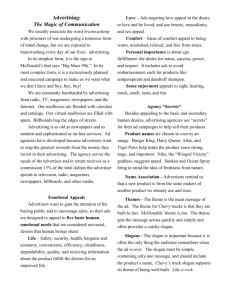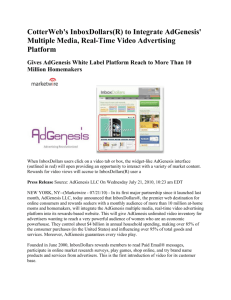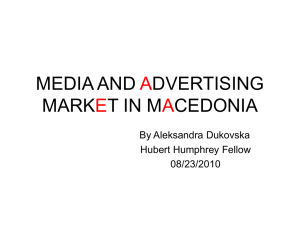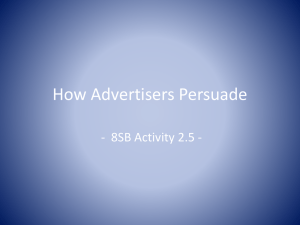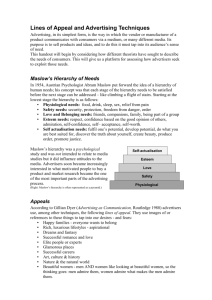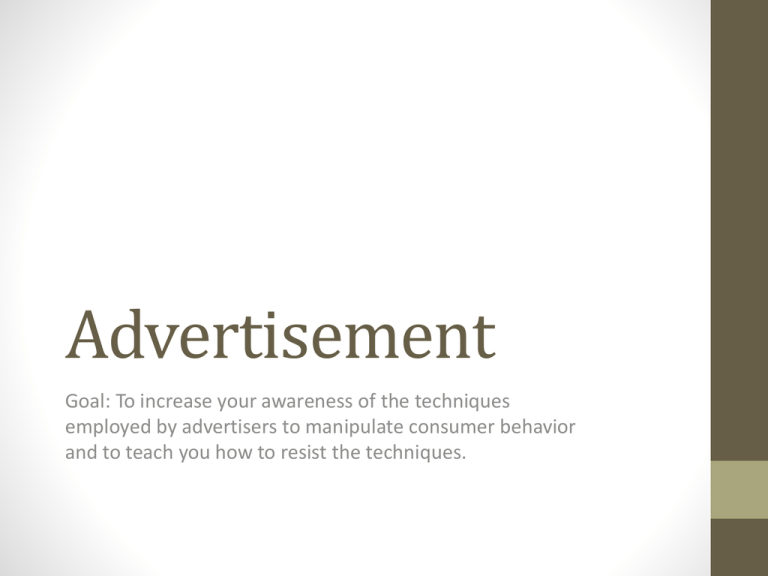
Advertisement
Goal: To increase your awareness of the techniques
employed by advertisers to manipulate consumer behavior
and to teach you how to resist the techniques.
Introduction
• Advertising is a powerful source of influence and that many of
our everyday decisions are subtly shaped by the ads that we
see, hear, and smell. By learning more about advertising and
being consciously aware of the techniques used to persuade
us to buy certain products or act in a certain way, we may be
less likely to be persuaded to do something we might
otherwise choose not to do.
Purpose of Advertising
• Why do companies Advertise?
• Do you think advertisers always tell the truth about their
products?
• The purpose of advertising is to sell products.
• Many advertisers do not merely present the facts but may
actually exaggerate the claims of their products in order to
persuade people to buy them.
• On occasion, some advertisers may even be deliberately
deceptive.
What are the different forms of
advertising?
•
•
•
•
•
•
•
•
•
TV Commercials
Radio commercials
Magazine ads
Newspaper ads
Billboards
Internet ads
Ads at the movies
Ads on buses or taxis
Ads on trains or in the subway
Advertising Techniques
• Advertisers have learned from past experience and test
marketing how to most effectively persuade consumers to buy
their products or services.
• Advertisers “TARGET” the particular group of people who are
the most likely to buy a particular product or service. This is
called a “TARGET GROUP”.
• Advertisers may have a relatively broad target group (i.e.
teenagers) or they may have a relatively specific target group
(i.e. teens who ride mountain bikes, teens who are dog
owners, left handed teens who are baseball players).
• Advertisers use special methods or techniques to sell to a
target group. These techniques include a stated message(what
the ad actually says) and an implied or hidden message.
• http://www.youtube.com/watch?v=WMDPql6rweo&feature=
g-vrec&context=G248bfdfRVAAAAAAAAAA
Advertising Techniques
• Celebrity Endorsement: Has a famous or well known person
(i.e. movies stars or athletes) talks about how great the
product is or that they use it themselves. Creates the
impression that the product must be good if they use it, and if
you want to be like them you should use it too.
Advertising Techniques
• Voice of authority: Has experts or authorities such as doctors
or scientists ( or actors playing the part of the expert) talk
about the effectiveness of the product such as toothpaste or
pain medicine. . Since they are experts, advertisers count on
the fact that consumers are likely to believe what they say
about how the product works.
Advertising techniques
• Scientific Evidence: Presents “facts” and statistics from
surveys supporting the effectiveness of particular products.
This is often combined with the voice of Authority.
Advertising Techniques
• Comparisons Tests and Opinion Polls: Presents the results of
consumer opinion polls or “taste test” involving direct
comparison of similar (competing) products. These ads intend
to show that most people like Brand A over Brand B, or
Product X is stronger, lighter, safer or less expensive than
others products.
• Demonstrations: Intended to show how well a product works.
Some of these advertisements have been found to be rigged
by advertisers to make the product look much better than it is
(Dishwasher soap, window cleaners, vacuum cleaners).
Advertising Techniques
• Demonstrations: Intended to show how well a product works.
Some of these advertisements have been found to be rigged
by advertisers to make the product look much better than it is
(Dishwasher soap, window cleaners, vacuum cleaners).
• http://www.youtube.com/watch?v=fUjz_eiIX8k
Advertising Techniques
• Bandwagon Appeal: Intended to create the impression that
everybody is using a particular product and because everyone
is using it you should too.
•
http://www.youtube.com/watch?feature=player_embedded&
v=VQ3d3KigPQM
Advertising Techniques
• Romance/ Sex appeal: Uses very attractive models in a way
that implies that using the product will make te person using it
more romantic or sexually attractive.
Advertising Techniques
• Maturity/ Sophistication Appeal: Intended to show that if you
buy a certain product you will be more grown up,
sophisticated, and fashionable.
• Fun/ Relaxation appeal: Intended to sell the product by
convincing you that it will help you have more fun or feel more
relaxed
Advertising Techniques
• Popularity Appeal: Intended to convince you to buy a certain
product by implying that if you use it you will be more popular.
Advertising Techniques
• The Deal Appeal: Tries to create a sense of urgency and
excitement by implying that this deal is too good to pass up.
Generally focuses on price and creates a sense of urgency by
saying that the deal ill end soon because the sale price is only
good for a few days and or there is a limited supply of the
product.
Test your Media Literacy
• http://www.youtube.com/watch?feature=player_embedded&
v=Fqqpzp8Ji94#t=0s

